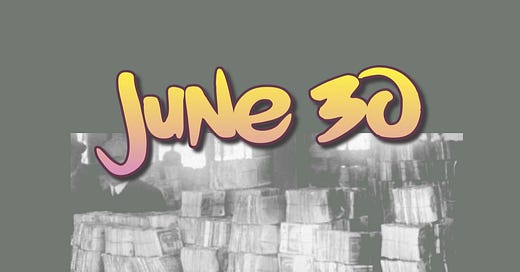Good morning contrarians! It’s the last day of the second quarter and the last day of the first half of 2022. It’s been a tough six months — worth first half of the year since 1970 — but at least now you know what a bear market looks like.
Yesterday stocks returned to treading water, finishing mostly flat. The one outlier was the Russell 2000 which tracks small caps. That gave up 1% on the day.
State of Play
As of 0630 this morning, stocks are continuing their descent: Nasdaq futures are down 1.8% with S&P 500 futures off 1.6%.
Industrial metals are selling off in the latest sign of a slowdown in global economic growth (or fears thereof): Copper is down 1.5%. WTI crude oil is flat though, changing hands at $109/barrel.
Cryptos are continuing to get beat up, with bitcoin down 5% to drop closer to $19,000. Bonds are seeing a few bids with the yield curve moving closer to inversion: the 2-year yield is down 5 basis points to 3% whilst the 10-year is up 3bps to 3.06% (yields move inversely to prices).
Economic Data
The Bureau of Economic Analysis’ Personal Consumption Expenditures Price Index, otherwise known as the PCE Deflator, is the main data release for today. This is the Fed’s preferred inflation gauge, so it goes a long way toward determining interest rate policy. As you hopefully know by now, inflation is running hot AF and the Fed has no choice but to stomp on the gas pedal where interest rates are concerned — even if it triggers a recession. Fed Chair Jerome Powell even said as much in public comments yesterday.
Anyway, economists expect the Core PCE Price Index — which excludes food and energy — to come in at 4.8% for May, a slight decrease from the 4.9% seen for April. That’s the key metric, though there are a bunch of other ones that come with this report.
As you can see from the chart, this number has actually been decreasing a bit since it peaked in February. For all practical purposes though, nobody is really going to be able to tell the difference between a 4.8% and 5.4% core PCE. In fact, economists are actually expecting an increase in the month-over-month core PCE (0.4% from 0.3% in April). So inflation is just too hot and the Fed needs to cool it down. Hence, higher interest rates.
Seeing how it’s Thursday we also have initial jobless claims out at 0830, the same time as the PCE report and likely to be overshadowed for that reason. Economists expect 228,000 new claims this week, about in line with the 229,000 seen last week.
The Chicago PMI is out at 0945. The expectation here is for a print of 58, below last month’s 60.3.
China Caixin Manufacturing PMI is out tonight at 2145. Anticipation is for a reading of 50.1, barely above the 50 level that separates expansion from contraction. Last month this came in at 48.1.
Earnings
Constellation Brands (STZ) and Walgreens Boots (WBA) report before the open at 0930. After the close at 1600 we will hear from Micron (MU).
The Bottom Line©
Like the CPI (the other major inflation reading) the core PCE does not often deviate very much from economist estimates. It’s been six months since it even missed by more than 0.10 percentage points. When it does miss by more than that, it’s usually by 0.2ppt.
So a narrow miss could be a big deal — in either direction. Maybe if the month-over-month doesn’t show an increase as expected, we will get a bit of a relief rally. But you have to think this is a bit of a long shot. The longer term trend clearly demonstrates stubbornly high inflation and the Fed has made clear they are going to do what is necessary to bring it down. So from that perspective this whole PCE deflator could be a non event.
Semester End Expounding
If these last six months have showed us anything, it’s how quickly and violently the consensus can shift — and with no real warning, either. At the start of the year very few were predicting a bear market. Now, the bears certainly look vindicated. On the bright side, as annoying as permabears are they are nowhere near as bad as the crypto cult. At least it’s somewhat entertaining watching the bitcoin bros spin their denial.
As for the economy, nobody knows how much more pain is ahead, or indeed if the damage is even contained. There just doesn’t appear to be anything that can head off this collision: when tighter monetary policy meets growth, monetary policy (the Fed) wins. That’s how it was in 2000/01, the last time we had a venture capital bubble. The only difference is how quickly interest rates upset the whole apple cart. Alan Greenspan needed to raise several times to prick the bubble. This time, tech started melting down before the Fed even touched the dial.
The labor market is still quite healthy, but that can be a lagging indicator. As liquidity washes out of the system, it brings down companies that are not well capitalized or are backed by growth capital. Investors cash in their chips and a cycle of blood-letting begins. That’s when you see firms going out of business and layoffs and the like. Then the unemployment rate rises and economic contraction sets in.
This doesn’t have to come to pass of course. There are any number of scenarios for how we can avoid it. Whatever your thoughts on this remember to do your own research and make your own decisions.













Share this post